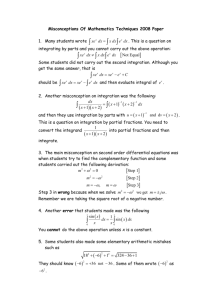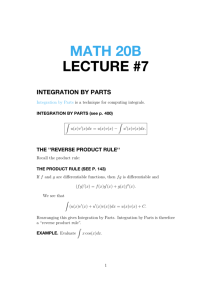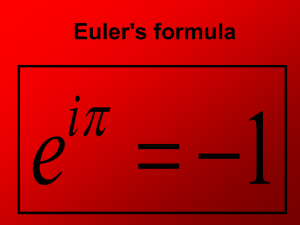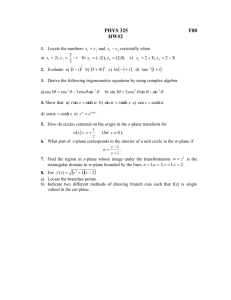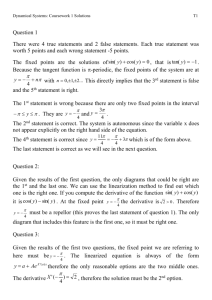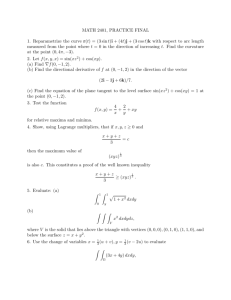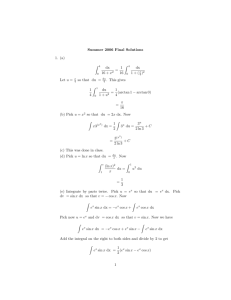MA 222 Integration by Parts Trick K. Rotz There's a trick for specific
advertisement
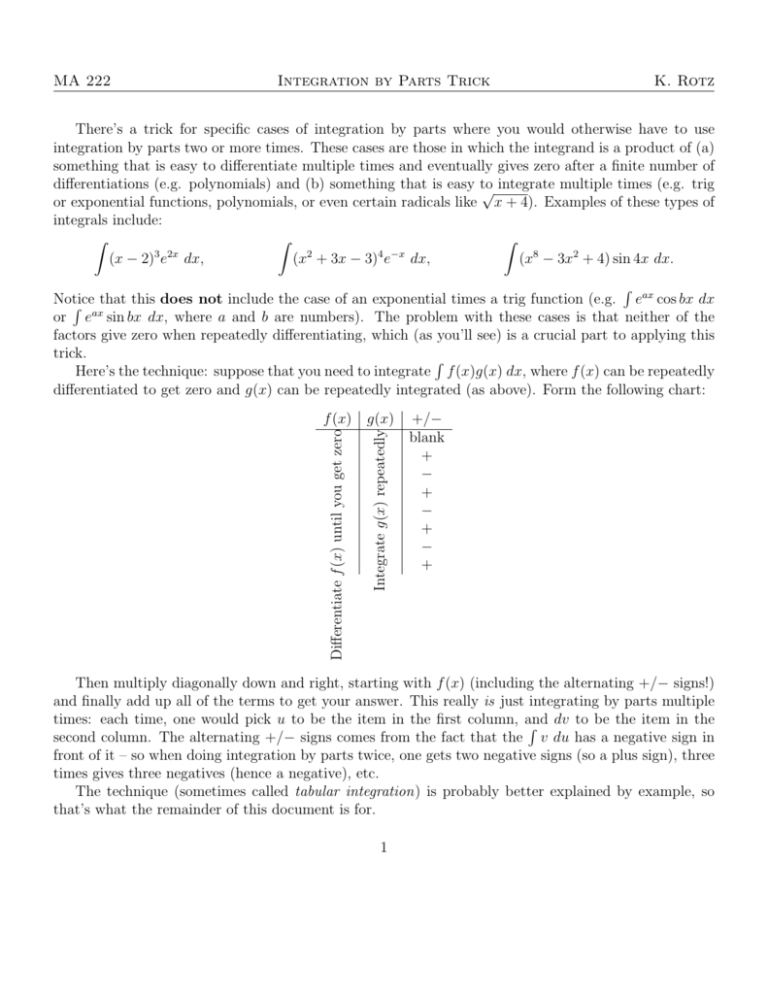
MA 222 Integration by Parts Trick K. Rotz There’s a trick for specific cases of integration by parts where you would otherwise have to use integration by parts two or more times. These cases are those in which the integrand is a product of (a) something that is easy to differentiate multiple times and eventually gives zero after a finite number of differentiations (e.g. polynomials) and (b) something that is easy to √ integrate multiple times (e.g. trig or exponential functions, polynomials, or even certain radicals like x + 4). Examples of these types of integrals include: Z Z Z 3 2x 2 4 −x (x − 2) e dx, (x + 3x − 3) e dx, (x8 − 3x2 + 4) sin 4x dx. R ax Notice R axthat this does not include the case of an exponential times a trig function (e.g. e cos bx dx or e sin bx dx, where a and b are numbers). The problem with these cases is that neither of the factors give zero when repeatedly differentiating, which (as you’ll see) is a crucial part to applying this trick. R Here’s the technique: suppose that you need to integrate f (x)g(x) dx, where f (x) can be repeatedly differentiated to get zero and g(x) can be repeatedly integrated (as above). Form the following chart: Integrate g(x) repeatedly Differentiate f (x) until you get zero f (x) g(x) +/− blank + − + − + − + Then multiply diagonally down and right, starting with f (x) (including the alternating +/− signs!) and finally add up all of the terms to get your answer. This really is just integrating by parts multiple times: each time, one would pick u to be the item in the first column, and R dv to be the item in the second column. The alternating +/− signs comes from the fact that the v du has a negative sign in front of it – so when doing integration by parts twice, one gets two negative signs (so a plus sign), three times gives three negatives (hence a negative), etc. The technique (sometimes called tabular integration) is probably better explained by example, so that’s what the remainder of this document is for. 1 MA 222 Integration by Parts Trick Z Example 1. Compute K. Rotz √ x2 x − 3 dx. √ Solution: Repeatedly differentiating x2 gives 2x, 2, and 0. x − 3 is simple to repeatedly integrate (apply u-sub at each step, with u = x − 3, so du = dx; it effectively amounts to the power rule each time). Thus the technique applies. Forming the chart: x2 (x − 3)1/2 +/− 2x 2 (x 3 − 3)3/2 blank 2 4 (x 15 − 3)5/2 + 0 8 (x 105 − 3)7/2 − + 0 As soon as you get a zero in the first column, you can stop integrating down the second column, but you should still put the next sign in the third column. Starting from the top-left corner (the x2 ) and multiplying diagonally down-right, we get the sequence of terms 2 4 8 (x2 )( (x − 3)3/2 )(+1), (2x)( (x − 3)5/2 )(−1) (2)( (x − 3)7/2 )(+1) 3 15 105 or, combining terms, 2x2 8x 16 (x − 3)3/2 , − (x − 3)5/2 (x − 3)7/2 . 3 15 105 Now add them all up, and throw in a +C for the final answer: Z √ 8x 16 2x2 (x − 3)3/2 − (x − 3)5/2 + (x − 3)7/2 + C. x2 x − 3 dx = 3 15 105 By applying the product rule to√the first two terms, it’s easy to check that this is the correct answer and that one gets back (x + 1)2 x − 3 when differentiating. Parenthetical Remark : This is actually a function for which it is easier to do by u-sub: let u = x − 3, so du = dx. The integral transforms into Z Z Z √ √ 2 2 (u + 3) u du = (u + 6u + 9) u du = u5/2 + 6u3/2 + 9u1/2 du 2 12 = u7/2 + u5/2 + 6u3/2 + C 7 5 2 12 = (x − 3)7/2 + (x − 3)5/2 + 6(x − 3)3/2 + C. 7 5 2 MA 222 Integration by Parts Trick K. Rotz These look like totally different answers and we broke math. But fear not! If one factors out (x − 3)3/2 from the first answer obtained by integration by parts, we’re left with 2 2 8 16 3/2 2 (x − 3) x − x(x − 3) + (x − 3) , 3 15 105 whereas if we do it to the second answer that was obtained via u-sub, what’s left is 2 12 3/2 2 (x − 3) (x − 3) + (x − 3) + 6 . 7 5 Expanding the squares and distributing everything out in the parentheses, we’re left with Z √ 2 2 24 48 3/2 2 x + x+ +C x x − 3 dx = (x − 3) 7 35 35 in both cases. We can conclude that, even though the answers look different when different methods are used, they are in fact the same answer. Z Example 2. Compute x4 sin(2x) dx. Solution: First note that the trick can be used, since (a) repeatedly differentiating x4 gives 4x3 , 12x2 , 24x, 24, and 0, and (b) sin 2x is easy to integrate multiple times. So we form the chart: x4 sin 2x +/− 4x3 − 12 cos 2x blank 12x2 − 14 sin 2x + 24x 1 8 cos 2x − 24 1 16 sin 2x + 0 1 − 32 cos 2x 0 − + Each integration of sin 2x kicks out a factor of 21 , which you can see by applying u-sub at each step, or just treating it as a sort of “inverse chain rule.” Be careful, though: if there were something like an x2 3 MA 222 Integration by Parts Trick K. Rotz R R 2 inside the sine, this wouldn’t be possible, e.g. sin(x2 ) dx 6= − cosx2x . [Neat history fact: sin x2 dx is another one of those integrals for which it is impossible to find an exact expression. Because of this, mathematicians have named it the “Fresnel S” integral. It (and its cousin the Fresnel C integral), do appear in applied topics such as optics]. Starting from the top-left corner of the chart, multiply down and to the right to get the sequence of terms 1 (x4 )(− cos 2x)(+1), 2 1 (24x)( sin 2x)(−1), 16 1 (4x3 )(− sin 2x)(−1), 4 1 (24)(− cos 2x)(+1) 32 1 (12x2 )( cos 2x)(+1), 8 or, after simplifying the individual terms, x4 cos 2x 2 3x − sin 2x, 2 − x3 sin 2x, 3x2 cos 2x, 2 3 − cos 2x. 4 Finally, add them all up and throw in a +C to get the answer: Z x4 3x2 3x 3 x4 sin 2x dx = − cos 2x + x3 sin 2x + cos 2x − sin 2x − cos 2x + C. 2 2 2 4 It’s simple (but extremely tedious since four applications of the product rule must be done) to verify that this is indeed the correct answer by differentiating the answer and simplifying all of the terms. This example, unlike the previous one, is not possible to do with u-sub. This is why this method is so useful, because otherwise one would have to integrate by parts four times in this example. 4

